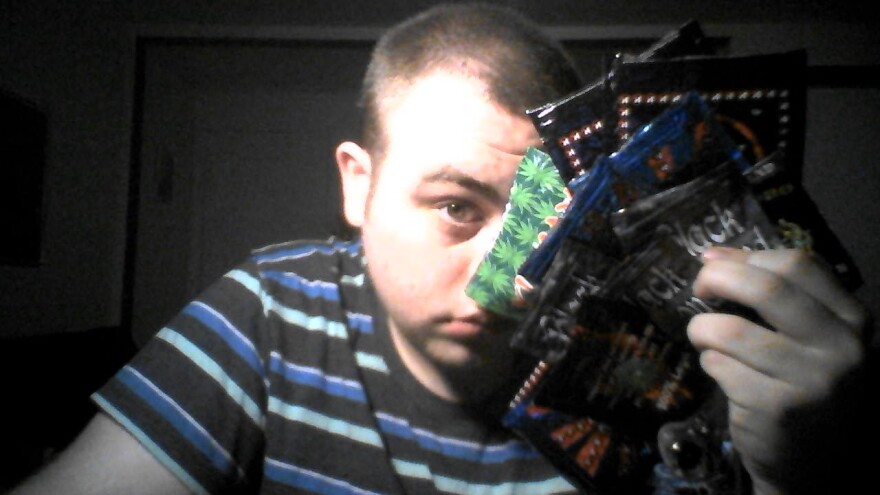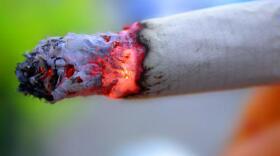Last November, our newsroom got an email from a guy in Manchester who said he wanted to share his story of spice addiction. He said: “It was not long for the culture of Spice within the city to suck my soul into the black hole.”
And then a couple months later, he left a voicemail.
"Just wanted to let you know I’m at the emergency room at Catholic Medical Center," he said. "I actually had to be treated for frostbite, and so I – why don’t you come by and see me right away. I’m more than happy to talk to you."
By the time I met him, Cameron, whose asked us not to use his last name, had been involuntarily admitted to a psych unit at New Hampshire Hospital.
"I’m here because I’m getting treated for my bipolar disorder along with psychosis," Cameron said.
But Cameron's psychosis most likely was not induced by his bipolar disorder. It was most likely trigger by his use of synthetic marijuana - or a combined impact of smoking spice and his mental illness.
Last August, Governor Maggie Hassan declared a state of emergency in response to a surge of overdoses from synthetic marijuana, or spice. Now a bill heading to her desk would make the sale, possession and consumption of those drugs illegal. But Cameron's story underscores that determined spice smokers may still be able to get their fix.
"What a big problem he's got"
On one hand, Cameron seemed manic when we spoke at New Hampshire Hospital, like his mouth was racing to keep up with his mind. But on the other hand, he had a lot of self-awareness. He knew he was there because smoking spice had thrown him into psychosis – essentially, a bad trip he couldn’t escape from.
"I had been up for far too long," Cameron says about the first time he overdosed on spice, "an episode of mania, my bipolar disorder, untreated at the time. And I was smoking the spice to try to bring myself back down and fall asleep, and went into shock and had a seizure. And it was pretty violent. It happened while I was at work."
Since then, he says he's had two or three more seizures.
It was not long for the culture of Spice within [Manchester] to suck my soul into the black hole. - Cameron, recovering spice user
Like marijuana, synthetic cannabinoids stimulate receptors all over the brain. But unlike marijuana, sometimes the body can’t deactivate spice. The liver breaks the drug down, but in some people those broken down bits keep circulating in the blood, stimulating the brain, making them high – or psychotic.
Spice hit the U.S. market in 2008, and by 2013, 14 percent of New Hampshire teens had used it.
Even before he started buying spice from convenience stories in Manchester two years ago, Cameron had become too comfortable with over-the-counter drugs. During his freshman year at Georgia Tech, he landed nine felony charges for making drugs in his dorm room. He was isolating dextromethorphan from cough syrup – the active ingredient that can make you high.
"I was a bit shocked and even irate," says Cameron's dad, David. "Alright, somebody’s taking drugs, or somebody’s smoking pot, or whatever. But he was really working hard to do chemistry and to extract compounds. It’s just like, Oh my God, he’s really putting his technical brains into this. To me, it just struck me then, what a big problem he’s got."
Unclear - but frightening - science
David has seen Cameron through the worst of his addiction and mental illness. But on March 2, when Cameron left me and apparently lots of other folks a message from the emergency room, his son wound up in restraints.

"He was telling us that he believed that this was all kind of like a reality TV show," says Dr. Lisa Mistler, who oversaw Cameron’s care at the state hospital. "And he engaged in some unusual behaviors as well. I noticed on the unit he was wearing multiple hats. He did have an irritable mood, and with some sort of what we call hypomanic mood, kind of running on a motor."
Cameron’s team at New Hampshire Hospital concluded he likely had an underlying mental illness, probably bipolar disorder. But that bipolar disorder never before made him delusional. That, they attributed, most likely, to the drugs.
"He said he had used spice, I think at one point his quote was for, you know, ‘thousands of hours,’" says Mistler.
Hospitals around the country are grappling with overdoses from spice. In one recent week in New York City, there were 120 ER visits because of synthetics, and 300 ER visits over one month in Alabama and Mississippi. Last year in New Hampshire, there were 44 overdoses in 72 hours.

And there’s another reason this drug is so dangerous: there’s zero quality control. Two bags of the same brand of spice could have wildly different concentrations of drugs. That’s because amateur chemists simply douse chemicals onto plant matter, could be weeds from a backyard. Sometimes this happens in China, and sometimes closer to home. Former U.S. Attorney for New Hampshire Jon Kacavas helped oversee the prosecution of two men who manufactured spice.
The law is catching up
Former U.S. Attorney for New Hampshire Jon Kacavas helped oversee the prosecution of two men who manufactured spice.
"These chemicals were being mixed in a barn in Epping," says Kacavas. "We have a photo of a 55-gallon drum, the exterior of which is caked with residue of AB-FUBINACA. It’s disgusting."
AB-FUBINACA is a synthetic cannabinoid originally created by the drug company Pfizer.
"The AB-FUBINACA is then mixed with this inert organic leaf material in cement mixers," he continues. "They would then take the mixture and spray that material with acetone. Acetone was being used as a drying agent, and acetone is commonly found in things like fingernail polish."
The AB-FUBINACA is then mixed with this inert organic leaf material in cement mixers. They would then take the mixture and spray that material with acetone. Acetone was being used as a drying agent, and acetone is commonly found in things like fingernail polish. - Former U.S Attorney for N.H. Jon Kacavas
Then it was packaged in baggies with flashy labels, and sold in stores around the state.
Spice is harder to get in New Hampshire today than it was a year ago. The Governor says she’s likely to sign a bill that would give the state broad authority to crack down on the possession, sale and consumption of synthetics. But several cities have already banned it, and former U.S. Attorney Kacavas says law enforcement has honed in on manufacturers.
"The education efforts that were underway last year about synthetic cannabinoids," says Kacavas, "this law enforcement action – really put a dent in the manufacturing and distribution of these toxic substances and took this stuff off the street and promoted public health and safety."
Off the street, but not off the Web, where Cameron continued to buy it after he couldn’t find it in stores. And so long as backyard chemists can tweak molecules, more dangerous, psychosis-inducing drugs are on the way. One called flakka caused a Florida man to try to kick down the door of a police station.
A fresh start
Cameron, though, has turned a corner.
"A lot’s changed," he says, in the six week since I first met him at the hospital. "So I’ve been discharged - no longer experiencing the daily psychosis that got me in the hospital."
Cameron is now in a group home in Dover, but he’s trying to move to another one in Manchester – the city where his spice addiction was at its worst. He wants to go back to college.
"Whether along the way that involves a relapse, I can’t say for sure," Cameron says. "I certainly hope not. But I know that if I pick up spice again that that’s going to come between me and my aspirations."
And perhaps that’s the best assurance a recovering addict can hope for.









